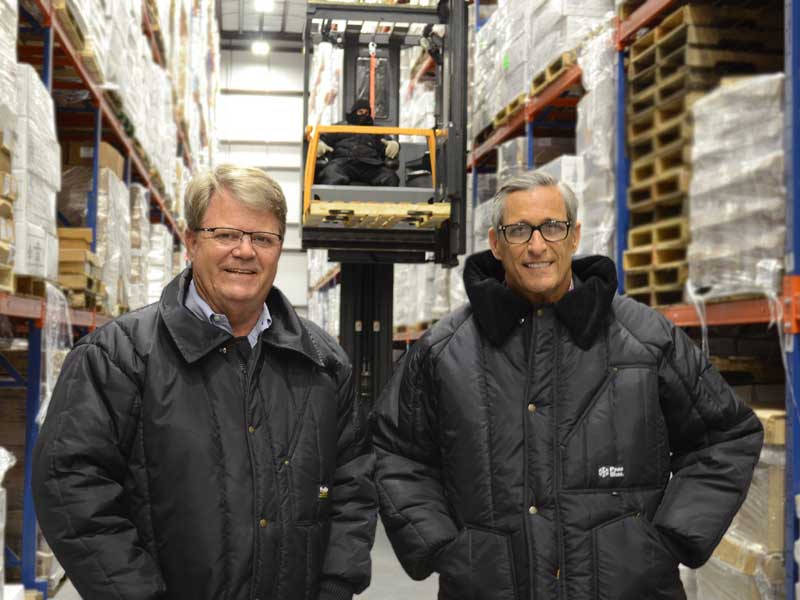by TERESA SCHIFFER
Technology is omnipresent in modern society, and with it we have seen monumental improvements across many sectors of industry. We can track the pizza we ordered, monitor work floors, and communicate with friends and coworkers around the world. It only stands to reason that new technology would also affect our food supply chain, too.
The world of cold food storage and transportation is awash in new technology. Now, more than ever, we are able to trace the journey of a box of frozen waffles or gallon of milk from production to the consumer. This allows a new vigilance that protects consumers while holding the supply chain systems accountable.
When the food comes out of the production facility it is loaded into a refrigerated truck or shipping container. Refrigeration makes it possible to ship food throughout the world. Food may be flash frozen before being loaded up, or it may arrive at storage to be frozen. The loading dock at the storage facility often has a sealant that helps maintain the temperature of the truck and the food. As the food is transported and maintained at particular temperatures, software allows for easy communication between producers, distributors, and retailers.
Cold foods often go through a distribution hub, such as Adams Cold Storage in Auburndale. This type of facility can serve as a warehouse for many different suppliers, so it’s important that the climate inside be carefully controlled. At Adams, they can store food at -5 to 65 degrees F, creating narrow temperature windows in individual rooms for safe storage.
The stringent control of temperature doesn’t begin at the warehouse, though. More and more companies are utilizing TTRs (time-temperature recorders) and other devices to ensure that their products are kept at a constant temperature throughout transportation. A TTR can record the temperature at given intervals (such as every 15 minutes) and record that information. Alternatively, tell-tale indicators will indicate whether the temperature has risen by a certain amount. This type of device is placed within the shipped pallet without the shipper’s knowledge to prevent them from turning off refrigeration systems to conserve fuel.
Once the shipment reaches the dock, an infrared thermometer can be used to verify the temperature of each item. Adams Cold Storage also uses cold-circuit television to monitor all those going in and out of the controlled environments. This way, if there is any issue with the product, they can trace the cold chain and find the problem. By building redundancies into the tracking system, product can be better controlled, saving everyone money in the long run.
A computerized system maintains the temperature in the various rooms of Adams Cold Storage, as well as monitoring the compressor and ammonia refrigeration system. Ammonia refrigeration is more efficient than Freon refrigeration, so though it costs more to install it will make up the difference in savings. The Genesis Control System used by ACS can detect leaks quickly so trained, certified staffers can make repairs. It only takes 50 parts per million of ammonia in the atmosphere to trigger a shutdown and require a hazmat response.
A system such as the Genesis can make a storage facility more efficient and streamlined. It allows for 24-hour monitoring, replacing the need for security guards. It also helps to save on electrical costs by cycling the refrigeration systems on and off automatically.
One interesting feature that Adams Cold Storage offers their clients is the ability to monitor their inventory remotely. By accessing the online system, shippers can see how much stock they have on hand to work with. This enables the distributors to request a certain amount of product be put on pallets and prepared to load so they can simply pick it up for delivery. A sealed dock guarantees that a product’s cold chain is never broken.
Adams has been working on the construction of a new warehouse which will be even more cutting-edge than their current facility. It will contain features on the forefront of cold storage technology, such as LED lights with motion detection sensors on them. The aisles will be narrower and accessible by turret truck, creating greater storage density. The turret truck allows operators to rise to the level of the product and grab it from there, rather than having to lower the pallet to the floor to get something from it.
The FDA’s Food Safety and Modernization Act requires certain upgrades in the way cold food is transported and stored, especially in the record-keeping department. It is becoming more important than ever that every step in the food supply chain be recorded and checked, in order to ensure the integrity of that chain. This can be vital information in the event of a product recall, like we’ve seen recently with Romaine lettuce and ground beef.
Moving forward, we can expect to see even greater emphasis on accountability in the cold food chain. RFID chip technology will be more widely used in order to better track products. We may also see more advances in the efficiency of refrigeration and insulation as well. However, whatever advances in technology we may see, Bruce Bachman, Executive Vice President at Adams Cold Storage, believes we’ll still need people. “We don’t know what we’ll be storing next week. Everything’s not the same size,” he says.
From corn dog nuggets to lobster tails, our cold food supply chain needs to be held to precise standards every step of the way. Companies like Adams Cold Storage are stepping up to provide the accountability required to ensure that food is kept at proper storage temperatures every step along the way – and new technology is making this easier than ever.

